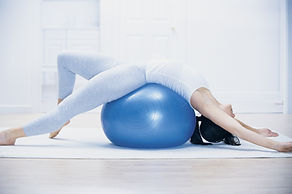
Pilates for Seniors
For the older population keeping fit is essential. But so many forms of exercise can be hard on the bodies of older adults. Many have turned to Pilates sessions at their local clubs as a way to stay in shape while reducing the risk of injury that weight-bearing exercises may cause. With its focus on controlled breathing and quality of movement-not quantity of repetitions-many experts agree that Pilates is one of the best ways for older adults to stay healthy.
Pilates is perfect for older adults because it does not have the impact on the body that other forms of exercise do, and is not nearly as severe on the joints as most workouts are.
It is really a gentle way to exercise. If you're an older adult and haven’t exercised in a while, Pilates is a safe way to restart a workout program.
Most conventional workouts tend to build short, bulky muscles more prone to injury–especially in the body of an older adult. Pilates focuses on building a strong "core"–the deep abdominal muscles along with the muscles closest to the spine. Many of the exercises are performed in reclining or sitting positions, and most are low impact and partially weight-bearing. It also can positively affect postural positions.
Increased Stability and Balance
Pilates centers on movements at the midrange of the body instead of the extremities (arms and legs), where, again, the potential for injury is greater. In contrast with other forms of exercise, Pilates develops the midrange and gradually works toward the end range, while maintaining complete control around the joints. To the benefit of older adults, Pilates teaches control and stability in a small range of motion, graduating to a larger range of motion as they gain control and confidence.
Increased control and stability is crucial for older adults as it can help them improve much of their functional movement, including balance and posture.
As people get older, they can lose some of their balance and coordination. Pilates increases strength and flexibility in both the core and the legs, which positively affects balance. This, along with basic fitness benefits, can help them reduce the risk of falls. And Pilates is also a good way for older adults to rehab from surgical procedures like a hip replacement or knee surgery.
Pilates helps with a variety of age-related ailments. Arthritis sufferers benefit because the gentle mid-range movements decrease the chance of joints compressing while maintaining the range of motion around them. For sufferers of osteoporosis or stenosis, Pilates can also help. For osteoporosis the simple and standing Pilates leg exercises may increase bone density in both the spine and the hip. For lumbar stenosis there are exercises that can stretch out tight back muscles and strengthen the extensor muscles of the spine to counteract the forces of gravity that can pull people into a hunched position.
Be careful, however. Any type of flexion exercise, for example, is not good for someone with osteoporosis. Conversely, any type of extension may cause injury to someone with stenosis. If you have either of these conditions it is important that you make sure your Pilates instructor knows how to modify the exercises so that you do not hurt yourself.
See also Pilates and Osteoporosis, Kyphosis , Injuries and Arthritis.
For further information, please do not hesitate in contact us.
info@connecthealthandfitness.com



